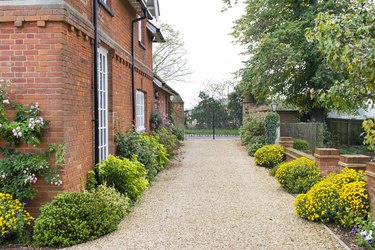
When considering attractive alternatives to asphalt and concrete driveways and walkways, two of the most popular ground covers are gravel and limestone. They're also big players in hardscaping purposes. When choosing which one to use, there are several factors a homeowner should keep in mind.
Aesthetic Appeal
Video of the Day
Gravel can be eclectic and unpredictable for color and pattern. What is gravel? It's a catch-all phrase for stones that are small and usually worn smooth. Generally, gravel is found near water sources, and water has honed the stones smooth over millennia. Gravel includes any color, composition or style of rock, including limestone.
Video of the Day
Also a sedimentary rock, limestone is comprised of calcium carbonate or dolomite. Limestone is frequently found in shades of gray, from nearly white to almost as dark as slate. But limestone can also include pale shades of yellows and browns. These softer tones make it a perfect understated, neutral component in landscaping or property design. When it's not solid limestone, you'll often find it listed as "crushed" limestone.
Stone Sizing
Size is an area where gravel and limestone diverge because limestone is a single-source product. This means limestone can be bought in everything from "crushed" limestone, which contains small stones of varying sizes, all the way up to large-cut flat pavers that are 24 inches by 36 inches.
Because gravel is comprised of various sedimentary rocks, it can be purchased in completely random source stones, if you're into that.
Both gravel and crushed limestone are often sold based on size. Sizing is classified as screenings, pea stones and stones.
Screenings start from what's virtually sand through to 3/16 of an inch in diameter. Pea stones are what we would also consider pebbles, from 3/16 to 1/2-inch in diameter. Finally, "stones" are 1/2-inch through to 4 inches wide.
If you're using this gravel or limestone for a driveway, be sure you check with the retailer to ensure it's "dense-grade." This means they've incorporated smaller stones as well as dust in the mixture and becomes bonded, even cement-like, making it a better surface to drive over.
Some retailers offer more specific choices for gravel or limestone cuts and sizes. Although getting specific may come at a premium price, it also offers you more control over the finished product's look.
Looking at Limestone
Limestone is widely used for aesthetic purposes, but it does have some drawbacks. It's a porous product, which means it's great for drainage uses – hence its popularity in gardens and pathways. But this porosity also means it's easily stained when it comes to rust, spilled paints, greases or acids. Acid is definitely an issue for limestone, so if your region is known for acid rain, then be aware that this can affect the appearance over time.
That said, it's worth noting that acidity tends to be more of an issue with limestone used as pavers and less with the crushed limestone one would use in gardens and driveways. Limestone is best used in regions without extreme weather fluctuations between seasons. In fact, limestone is excellent in hot, dry climates because it absorbs heat well rather than radiating it on hot summer days.
If you edge a limestone driveway or walkway with acid-loving plants, be aware that this stone will gradually leach lime into the soil, potentially raising the soil pH from acid to alkaline. This can be a drawback or a benefit; for example, if you want your bigleaf hydrangeas (Hydrangea macrophylla, USDA zones 6-11 depending on cultivar) to produce pink flowers (alkaline soil) instead of blue blooms (acid soil).
Its versatility makes limestone hugely popular with contractors and landscapers. It's used as concrete fill to make cement, to raise pH balance in gardens, as a roofing product in hot climates and more.
The Goods on Gravel
Gravel, because of its catch-all definition, includes all kinds of rocks, making it harder to know what sort of performance issues it may have in the long run. Being made up of so many different source stones, however, means it's likely that any performance issues will be confined to select components in the gravel, not the whole load, and will go unnoticed.
Gravel also tends to be a budget-friendly solution, which can make long-term performance less of a worry. This is especially true because the very nature of gravel's randomness means that adding more gravel over the life of your property can be easily incorporated and blended into existing gravel of the same size.
Limestone, on the other hand, generally has less aesthetic variation because it tends to come from a specific quarry, which may be a different quarry in the future. That could make later additions of crushed limestone seem more conspicuous.
Location, Location, Location
It's important to note that where you are can make some of this information moot. You could be in a poor region for either gravel or limestone, making that choice a more expensive factor.
Before spending too much time on the "gravel or limestone" question, the smart way forward is to find reliable service providers who can give you a good quote based on price, regional weather conditions and your planned use for the product. This will help you narrow down your choice.
Great Products, But the Choice is Yours
Ultimately, both limestone and gravel are terrific products with widespread appeal among landscapers and contractors all around the world – and for good reason. The only runaway factor that would make gravel a winner is if you're in an acidic rainwater region that could taint limestone over time, which is still largely an aesthetic consideration.
Beyond aesthetics, both are solid, flexible choices. In the end, cost, availability and appearance will likely be your largest considerations.